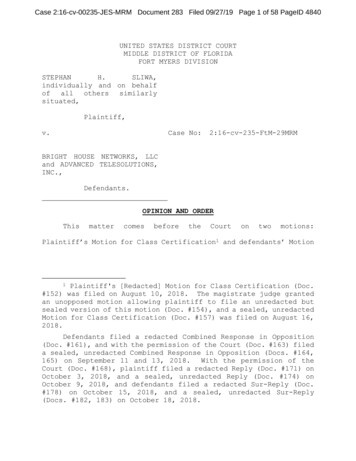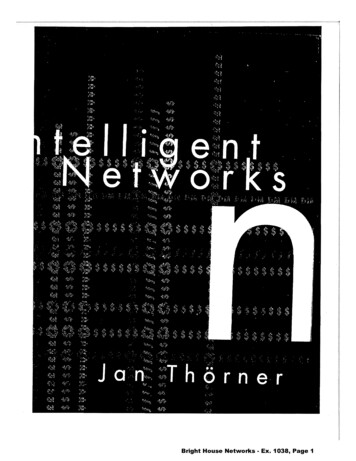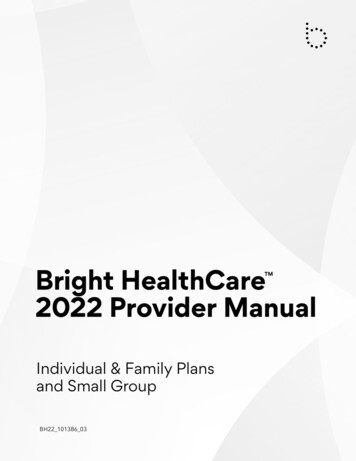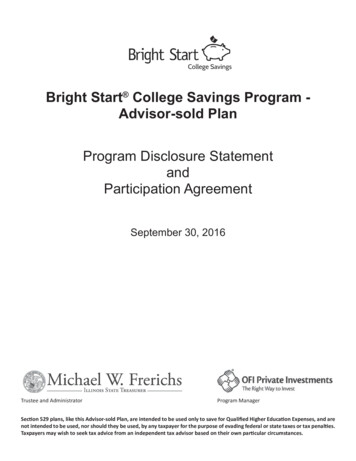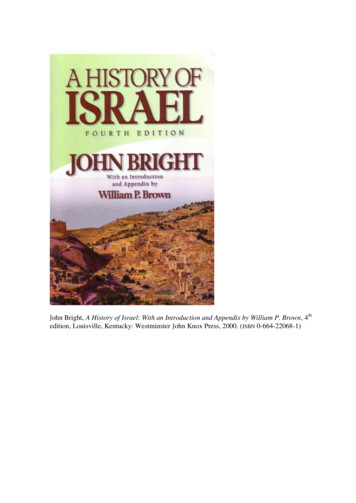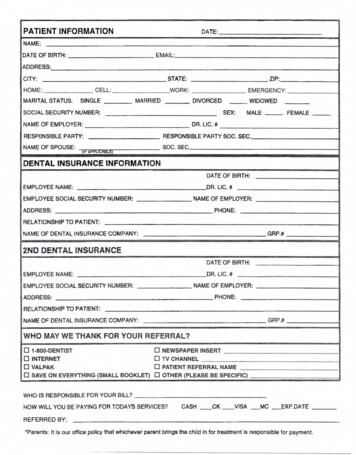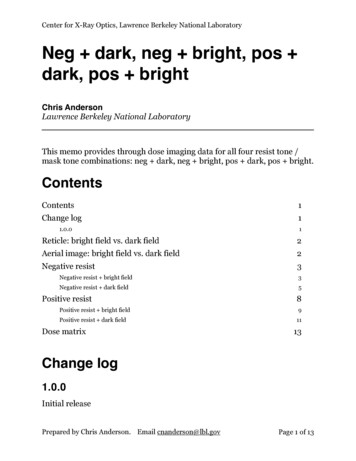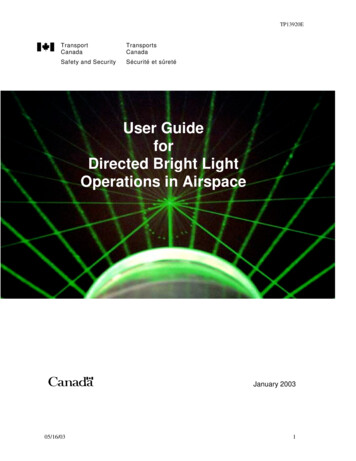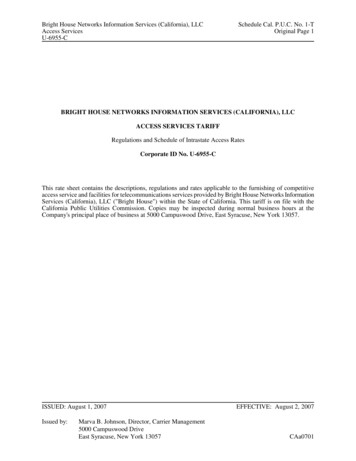
Transcription
Bright House Networks Information Services (California), LLCAccess ServicesU-6955-CSchedule Cal. P.U.C. No. 1-TOriginal Page 1BRIGHT HOUSE NETWORKS INFORMATION SERVICES (CALIFORNIA), LLCACCESS SERVICES TARIFFRegulations and Schedule of Intrastate Access RatesCorporate ID No. U-6955-CThis rate sheet contains the descriptions, regulations and rates applicable to the furnishing of competitiveaccess service and facilities for telecommunications services provided by Bright House Networks InformationServices (California), LLC ("Bright House") within the State of California. This tariff is on file with theCalifornia Public Utilities Commission. Copies may be inspected during normal business hours at theCompany's principal place of business at 5000 Campuswood Drive, East Syracuse, New York 13057.ISSUED: August 1, 2007Issued by:Marva B. Johnson, Director, Carrier Management5000 Campuswood DriveEast Syracuse, New York 13057EFFECTIVE: August 2, 2007CAa0701
Bright House Networks Information Services (California), LLCAccess ServicesU-6955-CSchedule Cal. P.U.C. No. 1-TTwelfth Revised Page 2Cancels Eleventh Revised Page 2CHECK SHEETThe pages listed below of this tariff are effective as of the date shown. Revised sheets contain all changes fromthe original tariff that are in effect as of the date Original12th Revised1st Revised11th RevisedOriginalOriginal1st RevisedOriginal1st RevisedOriginal1st RevisedOriginal1st RevisedOriginal1st RevisedOriginalOriginal1st nalOriginal1st ginalOriginal*** - indicates pages included in this filing.Issued: July 26, 2018Issued by:Betty Sanders, Vice President - Regulatory12405 Powerscourt DriveSt. Louis, MO 63131Effective: August 2, 2018
Bright House Networks Information Services (California), LLCAccess ServicesU-6955-CSchedule Cal. P.U.C. No. 1-TSecond Revised Page 3Cancels First Revised Page 3CHECK SHEET, ONOriginalOriginalOriginal1st l1st RevisedOriginalOriginalFirst ginalOriginalOriginalOriginalOriginalOriginal** - indicates pages included in this filingISSUED: January 30, 2012Issued by:EFFECTIVE: January 31, 2012Marva B. Johnson, Vice President, Government and Industry Affairs5000 Campuswood DriveEast Syracuse, New York 13057CAa1212
Bright House Networks Information Services (California), LLCAccess ServicesU-6955-CSchedule Cal. P.U.C. No. 1-TEleventh Revised Page 4Cancels Tenth Revised Page 4CHECK SHEET, 808182838485868788REVISION1st RevisedOriginal1st Revised1st RevisedOriginalOriginal1st RevisedOriginalOriginalOriginalOriginal6th Revised3rd Revised2nd Revised2nd Revised1st Revised1st RevisedOriginalOriginalOriginal1st RevisedOriginalOriginalOriginalOriginal***** - indicates pages included in this filingIssued: July 26, 2018Issued by:Betty Sanders, Vice President - Regulatory12405 Powerscourt DriveSt. Louis, MO 63131Effective: August 2, 2018
Bright House Networks Information Services (California), LLCAccess ServicesU-6955-CSchedule Cal. P.U.C. No. 1-TOriginal Page 5EXPLANATION OF SYMBOLSThe following symbols shall be used in this tariff for the purpose indicated below:CDIMNRTTo signify changed regulation.To signify discontinued rate or regulation.To signify increased rate.To signify a move in the location of text.To signify new rate or regulation.To signify reduced rate.To signify a change in text but no change in rate or regulation.TARIFF FORMATA.Page Numbering - Page numbers appear in the upper right corner of the page. Each page is numberedsequentially. However, a new page is occasionally added to the tariff. When a new page is addedbetween those already in effect, a decimal is added. For example, a new page added between page 15and page 16 would be page 15.1.B.Page Revision Numbers - Revision numbers also appear in the upper right corner of each page. Thesenumbers are used to determine the most current page version on file with the California UtilityRegulatory Commission. For example, the 4th Revised Page 15 Cancels the 3rd Revised Page 15.C.Paragraph Numbering Sequence - Each level of paragraph numbering herein is subservient to its nexthigher level as shown:22.12.1.12.1.1.12.1.1.A.1ISSUED: August 1, 2007Issued by:Marva B. Johnson, Director, Carrier Management5000 Campuswood DriveEast Syracuse, New York 13057EFFECTIVE: August 2, 2007CAa0701
Bright House Networks Information Services (California), LLCAccess ServicesU-6955-CSchedule Cal. P.U.C. No. 1-TOriginal Page 6TABLE OF CONTENTSCheck Sheet2Explanations of Symbols5Tariff Format5Table of Contents6Section 1Definitions and Abbreviations7Section 2Rules and Regulations13Section 3Description of Services41Section 4Rates and Charges76Section 5Miscellaneous Services and Charges79Section 6Special Contracts, Arrangements and Construction84ISSUED: August 1, 2007Issued by:Marva B. Johnson, Director, Carrier Management5000 Campuswood DriveEast Syracuse, New York 13057EFFECTIVE: August 2, 2007CAa0701
Bright House Networks Information Services (California), LLCAccess ServicesU-6955-CSchedule Cal. P.U.C. No. 1-TFirst Revised Page 7Cancels Original Page 7SECTION 1 - DEFINITIONS AND ABBREVIATIONS1.1DefinitionsAccess Code – Denotes a uniform code used by the Company to identify an individual Customer,normally in connection with routing originating switched Access Services. The code as the form101XXXX or 950-XXXX.Access Services – The provision of a communications path, using any appropriate technology, betweena Customer’s network and the communications service associated with a standard 10-digit telephonenumber assigned by the Company directly or indirectly to an end user or consumer that obtainsconnectivity to the Public Switched Telephone Network by means of that communications service. Forpurposes of this tariff, the Company’s Access Service includes the origination or termination ofinterexchange telecommunications traffic from or to any End User, either directly or via contractual orother arrangements with an affiliated or unaffiliated provider of interconnected VoIP service, asdefined in 47 U.S.C. § 153(25), or a non-interconnected VoIP service, as defined in 47 U.S.C. §153(36), where the provider of the VoIP service does not itself seek to collect compensation from theCustomer for that traffic, regardless of the specific functions provided by, or facilities used by, theCompany.(T) (T)Access Service Request (ASR) – The Service Order form normally used by access service Customersand the Company for the process of establishing, moving or rearranging access services provided bythe Company.Access Tandem (also referred to as Tandem Switch) – A switching system that provides a trafficconcentration and distribution function for originating and terminating traffic between End Officesand the Customer’s Premises or Point of Presence.Answer Supervision – The transmission of a switch trunk equipment supervisory signal (off-hook oron-hook) to a carrier’s Point of Presence or customer’s terminal equipment as an indication that thecalled party has answered or disconnected.Automatic Number Identification (ANI) – The automatic transmission of a caller’s billing accounttelephone number to a Customer or other entity, typically another Carrier. The primary purpose ofANI is for identification and billing of toll calls.Call - A completed connection between the calling and called End User parties. During a call, thecomplete address code (e.g., 0-, 911, or 10 digits) is provided to the Serving Wire Center, End Officeor Access Tandem switch.(L) (L)Certain material previously found on this page is now located on Page 7.1.ISSUED: January 26, 2012Issued by:EFFECTIVE: January 27, 2012Marva B. Johnson, Vice President, Government and Industry Affairs5000 Campuswood DriveEast Syracuse, New York 13057CAa1210
Bright House Networks Information Services (California), LLCAccess ServicesU-6955-CSchedule Cal. P.U.C. No. 1-TOriginal Page 7.1SECTION 1 - DEFINITIONS AND ABBREVIATIONS, (CONT'D)1.1Definitions (Cont'd.)Carrier - An entity other than the Company that provides telecommunications services.Casual Calling- Where access to the Company’s network and the subsequent use of service by theCustomer is initiated through the dialing of a toll-free number or Access Code. Casual Calling allowsnon-Presubscribed customers to utilize the originating Access Services of the Company.(L) (L)Central Office- The term “Central Office” has the same meaning as the term “End Office”, i.e., theswitching system office or serving wire center (or functionally equivalent or analogous facilities) fromwhich End Users receive exchange service. By way of example, system(s) or facility(ies) in a carrier’snetwork which host telephone numbers listed in the database of the Number Portability AdministrationCenter as assigned to the carrier, constitute an “End Office.”(L)(T) (L)(T)CIC- An interexchange carrier identification code.ISSUED: January 26, 2012Issued by:(L)EFFECTIVE: January 27, 2012Marva B. Johnson, Vice President, Government and Industry Affairs5000 Campuswood DriveEast Syracuse, New York 13057CAa1210
Bright House Networks Information Services (California), LLCAccess ServicesU-6955-CSchedule Cal. P.U.C. No. 1-TFirst Revised Page 8Cancels Original Page 8SECTION 1 - DEFINITIONS AND ABBREVIATIONS, (CONT'D)1.1Definitions (Cont'd.)Constructive Order – Delivery of calls to or acceptance of calls from the Customer’s network overCompany facilities constitutes a Constructive Order by the Customer to purchase switched AccessServices as described herein. The selection of the Customer by an End User as the End User’s PICalso constitutes a Constructive Order for Switched Access services by the Customer.Commission - The California Public Utilities Commission, unless otherwise indicated.Common Line – A Loop or Loop facilities.(N)Company –Bright House Networks Information Services (California), LLC, unless specifically statedotherwise.Connection to the PSTN: Any service or facility provided by a carrier that provides the purchaserof the service or facility with the ability to send calls to the PSTN, and/or to receive calls from thePSTN, based on one or more standard telephone numbers which are assigned by that carrier to theservice or facility and which are listed in the database of the Number Portability AdministrationCenter as assigned to that carrier.Customer – Any person, firm, partnership, corporation or other entity which uses service under theterms and conditions of this tariff. In most contexts, the Customer is an Interexchange Carrier thatuses the Company’s Switched Access services described in this tariff to reach its End User customersor to connect its End User customers with the Company’s End Users and/or other telecommunicationsproviders connected to the public switched telephone network. A Customer that uses Access Servicefrom the Company is responsible for the payment of charges hereunder and for compliance with theCompany's regulations and applicable law.(N) (N)(T)(T)Dedicated Access (also referred to as Special Access) - Where originating or terminating accessbetween an End User and a Customer are provided via dedicated facilities, circuits or channels. Amethod of reaching the Customer’s communication and switching systems whereby the End Useris connected directly to the Customer’s Point of Presence or designate without switching orequivalent call-specific routing of individual Calls.Disconnect - To render inoperable or to disable circuitry thus preventing outgoing and incomingtoll communications service.(L) (L)Certain material previously found on this page is now located on Page 8.1.ISSUED: January 26, 2012Issued by:EFFECTIVE: January 27, 2012Marva B. Johnson, Vice President, Government and Industry Affairs5000 Campuswood DriveEast Syracuse, New York 13057CAa1210
Bright House Networks Information Services (California), LLCAccess ServicesU-6955-CSchedule Cal. P.U.C. No. 1-TOriginal Page 8.1SECTION 1 - DEFINITIONS AND ABBREVIATIONS, (CONT'D)1.1Definitions (Cont'd.)DS0 – Digital Signal Level 0; a dedicated, full duplex digital channel with line speeds of 2.4, 4.8, 9.6,19.2, 56 or 64 Kbps.DS1- Digital Signal Level 1; a dedicated, high capacity, full duplex channel with a line speed of1.544 Mbps isochronous serial data having a line signal format of either Alternate Mark Inversion(AMI) or Bipolar with 8 Zero Substitution (B8ZS) and either Superframe (D4) or ExtendedSuperframe (ESF) formats. DS1 Service has the equivalent capacity of 24 Voice Grade or DS0services.DS3- Digital Signal Level 3; a dedicated, high capacity, full duplex channel with a line speed of44.736 Mbps isochronous serial data having a line code of bipolar with three zero substitution (B3ZS).Equivalent capacity of 28 DS1 Services.Material now found on this page was previously located on Page 8.ISSUED: January 26, 2012Issued by:EFFECTIVE: January 27, 2012Marva B. Johnson, Vice President, Government and Industry Affairs5000 Campuswood DriveEast Syracuse, New York 13057CAa1210(L) (L)
Bright House Networks Information Services (California), LLCAccess ServicesU-6955-CSchedule Cal. P.U.C. No. 1-TFirst Revised Page 9Cancels Original Page 9SECTION 1 - DEFINITIONS AND ABBREVIATIONS, (CONT'D)1.1Definitions (Cont'd.)End Office: The term "End Office" denotes the switching system office or serving wire center (orfunctionally equivalent or analogous facilities) from which End Users receive exchange service. Byway of example, system(s) or facility(ies) in a carrier’s network which host telephone numbers listedin the database of the Number Portability Administration Center as assigned to the carrier, constitutean “End Office.”(T) (T)End User: For purposes of this Tariff, the term “End User” means any person, corporation,partnership, or any other entity that purchases a service or facility from a Local Exchange Carrier(including the Company) that has one or more North American Numbering Plan numbers associatedwith the service, which numbers are listed in the database of the Number Portability AdministrationCenter as assigned to the Local Exchange Carrier, and which are used to switch traffic to and/or fromthe service. By way of example and not limitation, an End User may include an individual, a small ormedium-sized business, a business that purchases connection(s) for a PBX or functionally equivalentor analogous equipment, a dial-up Internet Service Provider, and/or a provider of interconnected VoIPservice (as that term is defined in the rules of the Federal Communications Commission) that obtainsits Connection to the PSTN from the Local Exchange Carrier. The term “End User” also includes aperson, corporation, partnership, or other entity that purchases interconnected VoIP service from aninterconnected VoIP provider.(T) (T)End User Premises – The premises specified by the Customer or End User for termination of AccessServices at the End User’s physical location.(T)(T)Equal Access – The provision of originating Switched Access to Customers by means of FeatureGroup D connections. With Equal Access, End Users can presubscribe their telephone line(s) to theirchoice of those Customers that subscribe to the Company’s Feature Group D Switched Access serviceat the Company End Office serving the End User. With Equal Access, outgoing non-local Calls dialedby the End User are automatically routed by the Company to the network of the End User’s selectedCustomer. Customers may also route calls to a Customer’s network by dialing that Customer’s AccessCode.Exchange – A group of connections to End Users served by the same switch or equivalent device andassigned the same “NXX” code in their telephone number. Each NXX code, and therefore eachExchange, is normally associated with a particular geographic area for purposes of billing distancesensitive charges. More than one Exchange may be associated with the same geographic area, and anEnd User’s retail local calling privileges will normally encompass multiple Exchanges.(L) (L)Certain material previously found on this page is now located on Page 9.1ISSUED: January 26, 2012Issued by:EFFECTIVE: January 27, 2012Marva B. Johnson, Vice President, Government and Industry Affairs5000 Campuswood DriveEast Syracuse, New York 13057CAa1210
Bright House Networks Information Services (California), LLCAccess ServicesU-6955-CSchedule Cal. P.U.C. No. 1-TOriginal Page 9.1SECTION 1 - DEFINITIONS AND ABBREVIATIONS, (CONT'D)1.1Definitions (Cont'd.)Holiday - For the purposes of this tariff recognized holidays are New Year’s Day, Memorial Day,Independence Day, Labor Day, Thanksgiving Day, and Christmas Day.Incomplete - Any Call where voice-grade transmission between End User equipment at the ends of thetransmission path is not established.Incumbent Local Exchange Carrier (ILEC) – With respect to an area, the local exchange carrier that (A)on the date of enactment of the Telecommunications Act of 1996, provided telephone exchange servicein such area; and (B)(i) on such date of enactment, was deemed to be a member of the exchange carrierassociation pursuant to section 69.601(b) of the Federal Communications Commission's regulations (47C.F.R. 69.601(b)); or (ii) is a person or entity that, on or after such date of enactment, became a successoror assign of a member described in clause (i).Material now found on this page was previously located on Page 9.ISSUED: January 26, 2012Issued by:EFFECTIVE: January 27, 2012Marva B. Johnson, Vice President, Government and Industry Affairs5000 Campuswood DriveEast Syracuse, New York 13057CAa1210(L) (L)
Bright House Networks Information Services (California), LLCAccess ServicesU-6955-CSchedule Cal. P.U.C. No. 1-TFirst Revised Page 10Cancels Original Page 10SECTION 1 - DEFINITIONS AND ABBREVIATIONS, (CONT'D)1.1Definitions (Cont'd.)Individual Case Basis or ICB – A process where by the terms, conditions, rates and/or charges for aservice provided under the general provisions of this tariff are developed or modified based on theunique circumstances in each case. ICB rates are determined using the rules and regulations forSpecial Service Arrangements as contained in Section 6 of this tariff.InterMTA – Telecommunications traffic exchanged between a LEC and a CMRS provider that, at thebeginning of the call (based on the originating and terminating call detail records), originates andterminates in different Major Trading Areas ("MTAs").(T)Interstate – For the purpose of this tariff, the term Interstate applies to the regulatory jurisdiction ofservices used for communications between one or more originating and terminating points located indifferent states within the United States or between one or more points in the United States and at leastone international location.IntraMTA – Telecommunications traffic exchanged between a LEC and a CMRS provider that, at thebeginning of the call (based on the originating and terminating call detail records), originates andterminates within the same Major Trading Areas ("MTAs").(T)Intrastate – For the purpose of this tariff, the term Intrastate applies to the regulatory jurisdiction ofservices used for communications between one or more originating and terminating points, all locatedwithin the state of Florida.Local Access and Transport Area (LATA) – A geographic area for the provision and administration ofcommunications services existing on February 8, 1996, as previously established by the U.S. DistrictCourt of the District of Columbia Civil Action No. 82-0192; or established by a Bell operatingcompany after February 8, 1996 and approved by the FCC; or any other geographic area designated asa LATA in the National Exchange Carrier Association (NECA) Tariff F.C.C. No. 4.Local or Local Traffic – For purposes of this Tariff, any call that (a) is between an End User of theCompany and an End User of a Customer and that (b) originates and terminates within the localcalling area established by the Customer (if any) for its End User.(N) (N)Loop: All lines, trunks, or other facilities connected directly or indirectly to an End Office Switch,between such Switch and an End User, that are used to provide a Connection to the PSTN.(N)(N)Certain material previously found on this page is now located on Page 10.1.ISSUED: January 26, 2012Issued by:(L) (L)EFFECTIVE: January 27, 2012Marva B. Johnson, Vice President, Government and Industry Affairs5000 Campuswood DriveEast Syracuse, New York 13057CAa1210
Bright House Networks Information Services (California), LLCAccess ServicesU-6955-CSchedule Cal. P.U.C. No. 1-TOriginal Page 10.1SECTION 1 - DEFINITIONS AND ABBREVIATIONS, (CONT'D)1.1Definitions (Cont'd.)Message - A completed telephone Call by a Customer or End User.OC-48 – A high capacity channel for full duplex, synchronous, optic transmission of digital signalsbased on the SONET Standard at a rate of 2.4 Giga bits per second (Gbps).(L) (L)Percent Interstate Usage (PIU) – The percentage of a Customer's total originating or terminating usagethat is jurisdictionally interstate based on the originating and terminating ANI included in the calldetail records, regardless of the technology used to originate and/or terminate the call. The PIU iscalculated by dividing the Customer's interstate minutes by the Customer's total (interstate plusintrastate) minutes. In determining the PIU, intrastate minutes include Local Usage minutes and thetotal minutes include indeterminate usage for which the jurisdiction of the traffic cannot be determinedbased on the call detail records.(N) (N)Percent Indeterminate Traffic (PIT) – the percentage of a Customer's total terminating switched accessusage for which the call detail records received by the Company do not contain sufficient originatingnumber information to allow for determination of the jurisdiction of that usage. The PIT is calculatedby dividing the Customer's indeterminate terminating access minutes by the Customer's totalterminating access minutes.(N) (N)Normal Business Hours - The hours of 8:00 a.m. to 5:00 p.m., Monday through Friday, excludingholidays.MTA – Major Trading Area, as defined in 47 C.F.R. § 24.202(a).OC-3 – A high capacity channel for full duplex, synchronous, optic transmission of digital signalsbased on the SONET Standard at a rate of 155.52 Mega bits per second (Mbps).OC-12 – A high capacity channel for full duplex, synchronous, optic transmission of digital signalsbased on the SONET Standard at a rate of 622.08 Mega bits per second (Mbps).Material now found on this page was previously located on Page 10.ISSUED: January 26, 2012Issued by:EFFECTIVE: January 27, 2012Marva B. Johnson, Vice President, Government and Industry Affairs5000 Campuswood DriveEast Syracuse, New York 13057CAa1210
Bright House Networks Information Services (California), LLCAccess ServicesU-6955-CSchedule Cal. P.U.C. No. 1-TFirst Revised Page 11Cancels Original Page 11SECTION 1 - DEFINITIONS AND ABBREVIATIONS, (CONT'D)1.1Definitions (Cont'd.)Premises - The space occupied by an individual Customer or Customer in a building, in adjoiningbuildings occupied entirely by that Customer, or on contiguous property occupied by the Customerseparated only by a public thoroughfare, a railroad right of way, or a natural barrier. May also denotea Customer owned enclosure or utility vault located above or below ground on a private property or onCustomer acquired right-of-way.Presubscription – An arrangement whereby an End User selects and designates to the Company orother carrier the Customer the End User wishes to access, without an Access Code, for completinginterLATA and/or intraLATA toll calls. The selected carrier is referred to as the PrimaryInterexchange Carrier.Primary Interexchange Carrier – The Customer designated by an End User as itsfirst routing choice for routing of 1 direct dialed and operator assisted non-local calls.Point of Presence – The physical location associated with a Customer’s network within a LATA inwhich the Company provides Access Services.PSTN or Public Switched Telephone Network: The public switched telephone network, sometimereferred to as the public switched network, consisting of the networks of all carriers that areinterconnected with each other, directly or indirectly, and that route telephone calls to and from theirentry and exit points on the network on the basis of 10-digit telephone numbers of the form NPANXX-XXXX.(N) (N)Query – The inquiry to a Company data base to obtain information, processing instructions or servicedata.Rate - Money, charge, fee or other recurring assessment billed to Customers for services or equipment.Service Commencement Date – The first day following the date on which the Company notifies theCustomer that the requested service or facility is available for use, unless extended by the Customer’srefusal to accept service which does not conform to standards in the Service Order or this tariff, inwhich case the service commencement date is the date of the Customer’s acceptance and or theConstructive Order date. The Company and a Customer may mutually agree on a substitute servicecommencement date.Service Order – A written request for access services executed by the Customer and the Company in aformat specified by the Company. Except for service provided by the Company under a ConstructiveOrder, the signing of a Service Order by the Customer and acceptance by the Company begins therespective obligations of the parties that order services offered under this tariff.(L) (L)Certain material previously found on this page is now located on Page 11.1.ISSUED: January 26, 2012Issued by:EFFECTIVE: January 27, 2012Marva B. Johnson, Vice President, Government and Industry Affairs5000 Campuswood DriveEast Syracuse, New York 13057CAa1210
Bright House Networks Information Services (California), LLCAccess ServicesU-6955-CSchedule Cal. P.U.C. No. 1-TOriginal Page 11.1SECTION 1 - DEFINITIONS AND ABBREVIATIONS, (CONT'D)1.1Definitions (Cont'd.)Serving Wire Center: A facility or location on the Company’s network that is capable of providingservice to Customers in the geographic area in which a Customer’s point of demarcation is located.The term is intended to include all locations on the Company’s network that perform the functionalequivalent of the functions performed by an incumbent local exchange carrier’s serving wire center.Switch, Switching, Switched: The term “switching” refers to any technical means by which acommunication is directed from an origination point or input source onwards towards a destination oroutput location. Switching may include (without limitation) either circuit or packet switching, andswitching of communications individually (including, if applicable, individual packets) or in groups,depending on the technology deployed. A “switch” is a device, software, or any technical arrangementthat performs or accomplishes switching. A communication is “switched” when it passes through aswitch. By way of example but not limitation, any device which determines how to route calls basedon the digits of a telephone number within the North American Numbering Plan is a “switch.”(N) (N)Switched Access – A service in which the Company establishes originating or terminating connectionsbetween an End User and a Customer by means of switching or routing on a Call-by-Call basis.(L)(L)TDM – Time Division Multiplexing – a method of transmitting and receiving voice signals over thePublic Switched Telephone Network (PSTN).(N)(N)Trunk – A communications path connecting two switching systems or equivalent devices in a network,used in establishment of an end-to-end connection.(L)(L)Trunk Group – A set of trunks which are traffic engineered as a unit for the establishment ofconnections between switching systems or equivalent devices in which all of the communicationspaths are interchangeable.(L) (L)VOIP-PSTN Access Traffic - VoIP-PSTN Access Traffic is Switched Access traffic exchangedbetween the Company and the Customer that originates and/or terminates in Internet protocol ("IP")format. Traffic originates and/or terminates in IP format if it originates from and/or terminates to aservice that requires Internet Protocol compatible equipment on an End User’s premises.(N) (N)VoIP service – Transmission of communications by wire, cable, radio, or other like connection inVoice Over Internet Protocol form, that is originated or terminated in Internet Protocol (IP) format.VoIP services are those services require the use of IP compatible equipment on an End User’spremises.ISSUED: January 26, 2012Issued by:EFFECTIVE: January 27, 2012Marva B. Johnson, Vice President, Government and Industry Affairs5000 Campuswood DriveEast Syracuse, New York 13057CAa1210
Bright House Networks Information Services (California), LLCAccess ServicesU-6955-CSchedule Cal. P.U.C. No. 1-TOriginal Page 12SECTION 1 - DEFINITIONS AND ABBREVIATIONS, (CONT'D)1.1Definitions (Cont'd.)United States - The forty-eight (48) contiguous states contained within the mainland United States, aswell as Alaska, American Samoa, Hawaii, the District of Columbia, Puerto Rico and the U.S. VirginIslands.1.2AbbreviationsANI -Automatic Number IdentificationBNA -Billing Name and AddressFCC -Federal Communications Commission (“Commission”)ICB -Individual Case BasisIXC -Interexchange CarrierPIC -Primary Interexchange CarrierPICC -Presubscribed Interexchange Carrier ChargePOP -Poi
Bright House Networks Information Services (California), LLC Schedule Cal. P.U.C. No. 1-T Access Services Second Revised Page 3 U -6955-C Cancels First Revised Page 3 CHECK SHEET, (CONT'D) PAGE REVISION 34 Original 35 Original 36 Original 37 1st Revised 38 Original 39 Original 40 Original 41 Original 42 Original
